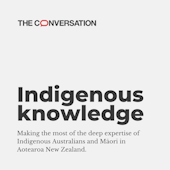
Indigenous Knowledge

Indigenous Knowledge has been set up as an institution on The Conversation’s platform so we can feature Indigenous knowledge that exists outside formal university settings.
Links
Displaying 81 - 100 of 102 articles

Spiny-tailed skinks, also known as meelyu, are culturally significant to the Badimia people in Western Australia. But habitat degradation and mining have put them at threat of extinction.

Recently, the Commonwealth government created a redress scheme to compensate Stolen Generations survivors. But more needs to be done to address the trauma.

With 300 stone artefacts submerged on Australia’s continental shelf last year, Indigenous underwater cultural heritage needs to be prioritised in marine science and industry practices.

The government recently announced a new reparations scheme for Stolen Generations survivors. However, these survivors are only a fraction of the Indigenous children separated from their families.

The remarkably resilient structure is in good health, for now. But work is needed to ensure it is preserved for future generations.

Opportunities to give voice to Aboriginal people in prison have the potential to address the growing impacts of racism in the justice system in Australia.

Plans are progressing to rebury the remains of some of Australia’s most significant inhabitants. But scientists say this will see the potential to learn more about the origins of humanity vanish.

Walking in the footsteps of First Nations peoples provides an alternative to overseas travel and an opportunity to reflect.

Reducing transport inequality and improving walkability in Indigenous communities are necessary to help close the health and social gap.

We have found 140 quarry sites, where rock was excavated to make seed grinding stones, in the Channel Country of Central Australia. It’s part of a major project testing Bruce Pascoe’s hypothesis.

Australians should see the rainforest as a cultural landscape – one that has been managed and maintained by people, rather than just a relic unchanged since the dinosaurs.

Tensions have been building over the last month following the killing of an Indonesian intelligence chief. The government has vowed to ‘chase and arrest’ all armed militants in the region.

Do we want to punish some of the most vulnerable young people in the community, or do we want to reduce re-offending? The Northern Territory’s proposed youth justice reforms suggest the former.

It was the site of historic gatherings, such as a four-day initiation ceremony for young men. Then colonial authorities quashed such practices. The place was lost for more than a century, until now.

By collaborating with Indigenous ranger groups, we can make strategic fire and land management practices economically sustainable for traditional landowners.

First Nations people have almost no say in how water is used in Australia. The Productivity Commission’s latest report does little to address that.

In depicting brutal massacres and mission life, this film gets a lot right. And the model for its central protagonist may well be a young man called Narlim, exiled from his country in the late 1930s.

Two starkly different research projects at East Gippsland’s Cloggs Cave, 50 years apart, show the importance of Indigenous perspectives in archaeology.

It was once thought the Aboriginal names for the Hawkesbury had been lost forever. But after a remarkable find in the Mitchell Library, almost 100 place names will be restored to Dyarubbin Country.

The decision recognises that water rights are critical for Indigenous people to restore customs, protect their culture, become economically independent and heal Country.
